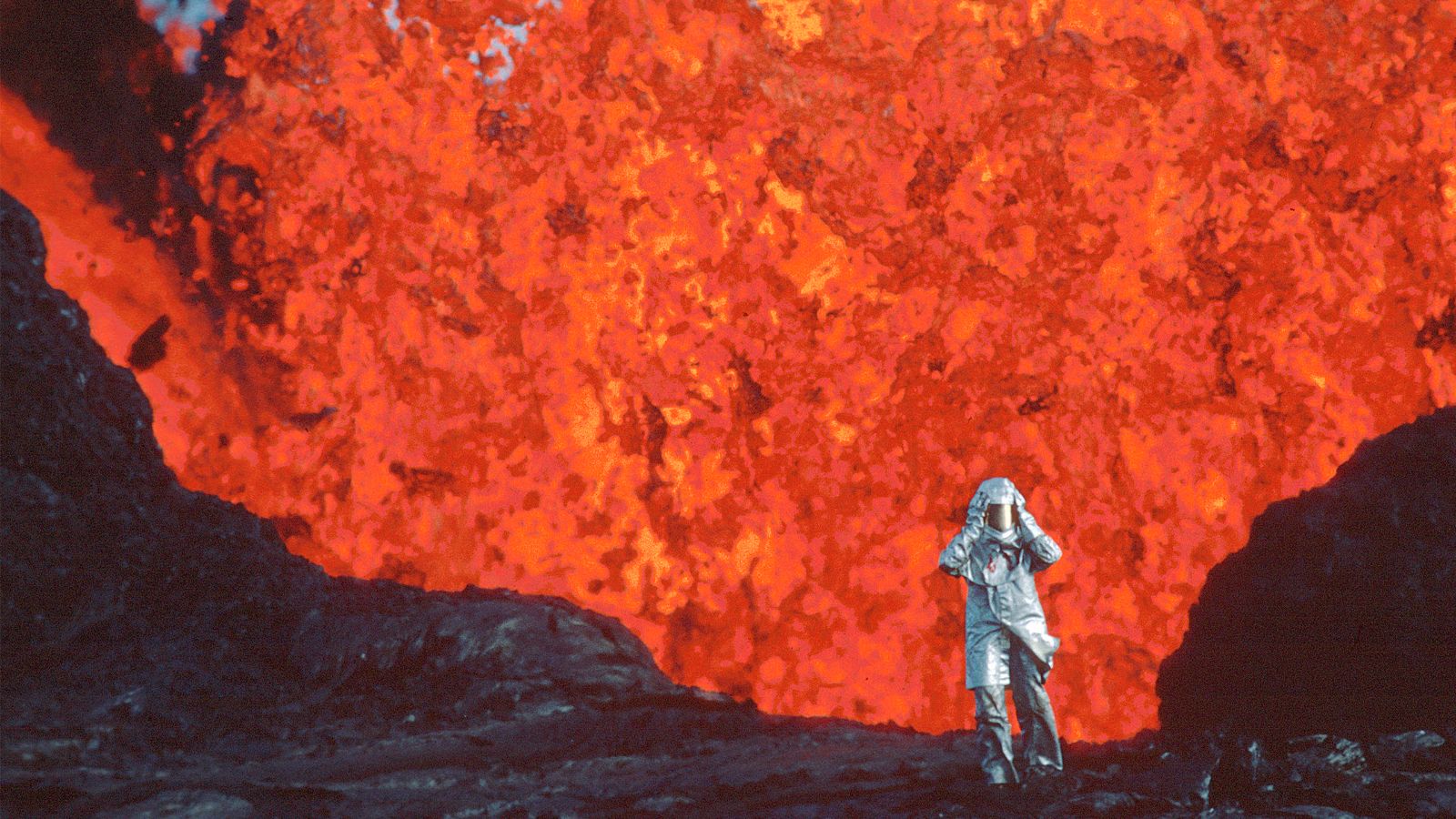In a bond forged over mutual fascination (or obsession) with the mysteries of volcanoes, Katia and Maurice Krafft dedicated their lives to discovering everything they could about these natural phenomena. Forces of both awe-inspiring wonder and tragic disaster, Sara Dosa’s archival documentary Fire of Love gracefully captures this extreme dichotomy while also getting to the heart of what drove this couple to abandon a routine, domesticated lifestyle and literally sacrifice their lives in the mission to save others. In telling their devotion to one of the natural world’s most dangerous forces, Dosa crafts a documentary that would make Herzog proud—and an ideal double feature with Into the Inferno, his collaboration with volcanologist Clive Oppenheimer, which also features the Kraffts.
Even if you’ve never heard of these volcanologists, the divulging of their death in 1991 at the base of a volcanic explosion is presented early on, layering the entire documentary with a sense of tragedy and urgency by knowing each step of their journey is a precious one. As narrator Miranda July foretells over a transfixing score by Air’s Nicolas Godin, they will leave behind hundreds of hours of footage, thousands of photos, and millions of questions. Smartly utilizing these archival materials, absent talking heads or heavy textual overlays, Dosa only trips up when adding a bit of cutesy animation to fill some gaps and convey their love––a truth we’ve already gleaned from the start. Though some expeditions were clearly better captured than others, one comes away with a rather complete picture of their ambitious, life-threatening drive thanks to their own writings and other interviews that were recorded.
A smash cut from enormous volcanic explosions to Vietnam War bombings tells of the French couple’s early days partaking in anti-war protests in Paris. Noting that they “got into volcanoes because they were disappointed with humanity,” they also carry with them a sense of humor, making the expected puns about their relationship and mutual passion. As self-proclaimed freelance “volcano runners,” questions of how they precisely funded their globe-trotting missions to the next eruption start to emerge and are briefly answered with lecture tours, media appearances, photo books, and their own films, though it’s an aspect one wishes was explored a bit more in-depth.
Conversely, Dosa gives plenty time to bask in astonishing footage the Kraffts captured. On visits to red volcanoes (aka the predictable, “friendly” ones) we see their bodies silhouetted against a wall of flaring, sky-high eruptions, so close they could reach out and touch the lava. Captured with Darth Vader-esque protective gear, the resulting images are so staggering in scope it renders most big-budget sci-fi spectacles tame in comparison. Along with mesmerizing underwater photography of volcanic eruptions—even a humorous shot of Maurice cooking eggs on magma—what the Kraffts were able to record is quite a feat. Building towards the inevitable finale, though, this journey turns from astonishment to calamity.
“I prefer an intense and short life to a monotonous, long one. A kamikaze existence in the beauty of volcanic things,” writes Maurice, already prophesizing his future. After Mount St. Helens’ eruption in 1980, which resulted in 25,000 atomic bombs worth of force and killed 57, the couple turned their life’s mission from red volcanoes to grey, aka the “killer” ones. Through their research and seeing the signs to come as it pertains to future eruptions, they hoped that the warning systems and evacuation plans they helped push forward would save lives. In heartbreaking footage, we see how Nevado del Ruiz erupted in 1985, causing mudslides that claimed the lives of around 25,000; if the Colombian government had heeded these volcanologists’ warning and not found their plans too costly, such extreme tragedy could’ve been prevented. But it was through their footage of its deadly aftermath that other governments started paying attention to the alerts based on research.
As Dosa goes on to tell the story of the Kraffts’ demise a few years later at the base of the 1991 Mount Unzen eruption in Japan, there is certainly a feeling of devastation, but also surprising calm. This was a couple who wanted nothing to do with the monotony of society, desiring to get closer to these perilous wonders as quickly as they could. “If I could eat rocks, I’d stay at volcanoes and never come down,” said Maurice, who even would make home-grown volcanoes when he was away because he missed them. They died doing what they loved, and Dosa is able to paint a thorough picture of this burning mutual desire, leaving no doubts they lived out their dreams. Fire of Love‘s title credits give equal billing to the volcanoes as co-stars, and the documentary shows the Kraffts’ harmonious curiosity with nature––even its most cataclysmic forces––to make the world a safer place is a lesson anyone could benefit from.
Fire of Love premiered at the 2022 Sundance Film Festival.

